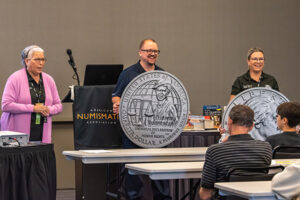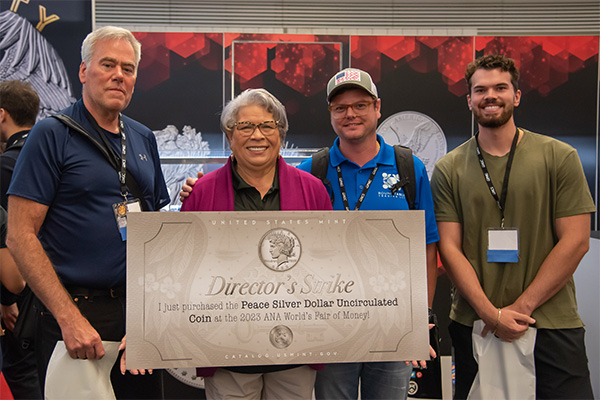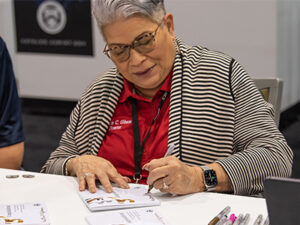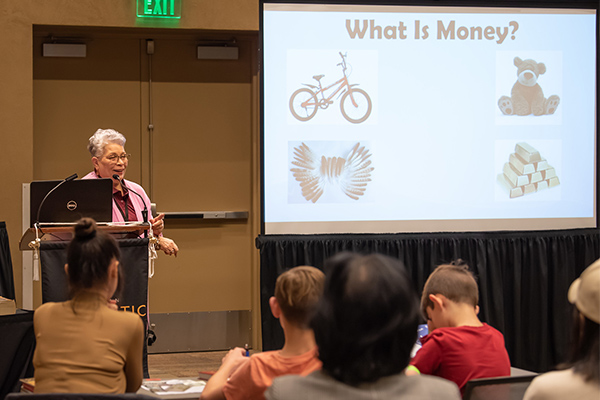


WASHINGTON – The United States Mint today released its latest educational video, “How Coins Are Made…For Kids!” on the organization’s YouTube channel.
The video features a mix of animations and live action footage and makes learning the basics of U.S. circulating coin production fun and engaging. Targeting younger audiences, the video is also suitable for anyone interested in the general process of producing a circulating U.S. coin.
The United States Mint also offers free, downloadable lesson plans available to educators and youth organizations interested in learning about U.S. coins. The lessons are developed for grades K-12 and cover subjects such as social studies, art, science, math, and language arts.
“How Coins are Made…For Kids” will be promoted during National Coin Week, April 17-23. The video may be viewed or downloaded at http://www.usmint.gov/kids/cartoons/birthOfACoin/.
About the United States Mint
The United States Mint was created by Congress in 1792 and became part of the Department of the Treasury in 1873. It is the nation’s sole manufacturer of legal tender coinage and is responsible for producing circulating coinage for the nation to conduct its trade and commerce. The United States Mint also produces numismatic products, including proof, uncirculated, and commemorative coins; Congressional Gold Medals; and silver and gold bullion coins. The United States Mint’s numismatic programs are self-sustaining and operate at no cost to taxpayers.
WASHINGTON, D.C. — The U.S. Mint today introduced its new online learning community, called “U.S. Mint H.I.P. Pocket Change” (History In your Pocket), which will provide a collaborative educational environment using coins as tools to teach American history, mathematics and language arts. The web site, developed in accordance with Vice President Al Gore’s “Information Superhighway” initiative, seeks to build interest in coins as tangible artifacts of history, art and math, and to encourage young people to build their own coin collections.
“Through the ages, coins have told the stories of the cultures they represent,” said Philip N. Diehl, Director of the U.S. Mint. “U.S. Mint H.I.P. Pocket Change is not only a great way for children and adults around the world to learn those stories, but it will also inspire them to hold onto a piece of history by collecting coins.
The U.S. Mint H.I.P. Pocket Change site, located at www.usmint.gov, is a free Federal web site that was created by a team of web–savvy teachers, the Mint and the Numismatic Guaranty Corporation of America. The teacher–oriented portion of the site offers lesson plans and project ideas that incorporate the educational value of coins into the learning process. The site will continue to be supplemented and maintained by the Mint with support from partners, including the Numismatic Guaranty Corporation of America, the American Numismatic Association and the educational community through Online Lesson Modules, which allow teachers to upload their new lesson plans, making them available to others.
Students in kindergarten through eighth grade will use U.S. Mint H.I.P. Pocket Change to design their own learning experiences through educational games. Kids can travel through time and cyberspace in a virtual time machine to answer coin–related questions from “HPC Pals” like Peter the Mint Eagle and Flip the Mint Seal. The project contemplates that kids will also have the opportunity to interact with students in classrooms nationwide, as well as coin experts and representatives from the U.S. Mint.
“Students learn more when they are having fun, and U.S. Mint H.I.P. Pocket Change provides plenty of entertaining graphics and animations while providing solid educational value,” added Diehl. “Parents will see their kids enjoy learning from the U.S. Mint H.I.P. Pocket Change web site, a safe place for children of all ages on the Internet.
U.S. Mint H.I.P. Pocket Change was developed as part of Vice President Al Gore’s campaign to ensure that teachers have the skills they need to use technology, and that children have access to learning tools that are as engaging as the best video games.
For more information on the U.S. Mint H.I.P. Pocket Change and other Mint initiatives, visit the Mint’s web site at www.USMINT.gov.

In the U.S. Mint Coin Classroom game, Gold Rush, players collect gold with the same tools used by miners during the California Gold Rush. This game is inspired by an important period in American and U.S. Mint history. Learn about how the real gold rush changed our country and our change!
Well before the gold rush, rocks in the Sierra Nevada mountain range in northern California contained gold deposits. Over thousands of years, the rock eroded and freed pieces of gold to float down streams and collect in streambeds.
In one of those streambeds, workers at Sutter’s Mill discovered gold in January 1848. Soon, people from Oregon, Mexico, Hawaii, and China journeyed to the territory of California for their share of gold. The word spread slower to the eastern United States. By the end of the year, the U.S. government received the first gold samples, and President James K. Polk announced gold had been found in California. The news caused excitement throughout the country!
In 1849, thousands of prospectors flooded into California. These gold-seekers were nicknamed “49ers.”
In one year, the non-native population of California went from around 1,000 people to nearly 100,000. Many of these new settlers formed camps and small towns, removing the local native people from their homes. In 1850, President Millard Fillmore signed a bill that made California our 31st state.
At the start of the California Gold Rush, prospectors used simple tools to separate the gold from the dirt, gravel, and sand. As gold became harder and harder to find, companies formed, using large-scale, destructive methods to pull the gold from the earth.
A gold pan was the simplest tool used by the early gold miners. The miner scooped gravel into the pan and swirled it with water. The lighter-weight dirt, sand, and gravel would wash out, leaving the heavier gold behind at the bottom of the pan. Using a pickaxe or shovel, the miner could loosen more dirt to scoop into the pan.
Many miners also used a wooden rocker. The miner shoveled dirt and gravel into a box with a mesh sieve, then poured water over it. The gold would separate from the dirt and collect at the bottom. The box could also rock back and forth on rails, like a cradle, to help shake more of the gold free.
Some miners built wooden sluice boxes to sort through larger amounts of dirt and gravel. As water and gravel was channeled through the sluice, the gold sank to the bottom. The rest of the rocks and dirt continued downstream.

After the miners found gold, they needed it made into coins. In 1854, the San Francisco Mint opened to process the huge amounts of gold. During its first year, the San Francisco Mint turned miners’ gold into over $4 million dollars in gold coins.
The most popular of these coins during the 1850s was the highest denomination, the double eagle, worth $20. The Mint created this denomination because of the large amounts of gold coming from California.
When miners brought their gold dust and nuggets to San Francisco, the Mint workers first melted it down. Melting separated out other metals that may have also been trapped in the nugget with the gold. The Mint could then make gold coins or gold ingots to return to the miner for spending or saving.
Today, the Mint still operates a location in San Francisco. The San Francisco Mint makes proof and commemorative coins.
Gold mining in California changed the environment forever. Mining methods used increasingly destructive tools and practices.
In the areas where miners worked, rivers and streams became wider and wider as miners dug up the banks to look for gold. The rivers carried large amounts of sand, gravel, trees, and other materials downstream. This created blockages, which destroyed farms, buildings, and even towns. Miners also blew up and tunneled through mountains to find gold deposits. They dumped the debris in nearby waterways, burying streams and land completely in gravel. Poisonous mercury, used to free gold from rock, seeped into the land and water. All of these practices killed trees, plants, fish, and wildlife.
In 1884, a judge ruled that mining debris could not be released into waterways used by farming. This ruling made it difficult for mining to continue. Farming then became the largest industry in California.

Start your own collection of quarters. By the end of this activity, you’ll have a quarter for each year you’ve been alive.
Grades: Kindergarten for the basic activity; 2nd grade and up for the extra questions in Step 5
Materials: coin holder or binder (optional), pencil, paper
Time: A few days or weeks to collect all the coins
Steps:
WASHINGTON — The United States Mint announced today that the Deputy Secretary of the Treasury has appointed Annelisa J. Purdie to the Citizens Coinage Advisory Committee (CCAC). Purdie is one of three members appointed to represent the interests of the general public. She replaces Dr. Lawrence Brown, whose four-year term on the CCAC expired on January 30, 2024.
Annelisa comes from three generations of coin collectors and enthusiasts. She inherited her love of numismatics from her grandparents and mother, beginning her collection at the age of six. She enjoys both learning about and sharing the history of coin production, design, and composition, and believes that coins provide excellent opportunities as educational tools for children.
Purdie holds a Bachelor of Arts in History from New York University, a Master of Arts in American Studies from Columbia University, and a Master of Library and Information Science (MLIS) from St. John’s University. A librarian by profession, she has spent much of her career in the youth services departments of the public library sector, where she often used the U.S. Mint for Kids resources in her outreach and activity sessions. She currently works as a research and reference librarian in the private sector.
Annelisa is also a member of the Black Caucus of the American Library Association. She serves on the Public and School Libraries Committee, where she advises on collection development, raising literacy awareness, and the annual Best of the Best booklists. A fifth-generation New Yorker and the daughter of Harlemites, she still resides in the city. She is an avid classic film fan and bibliophile.
About the CCAC
The CCAC was established by an Act of Congress in 2003. It advises the Secretary of the Treasury on theme or design proposals relating to circulating coinage, bullion coinage, Congressional Gold Medals, and other medals produced by the United States Mint. The CCAC also makes commemorative coin recommendations to the Secretary and advises on the events, persons, or places to be commemorated, as well as on the mintage levels and proposed designs.
The CCAC is subject to the authority of the Secretary of the Treasury. The United States Mint is responsible for providing necessary and appropriate administrative support, technical services, and advice. The CCAC submits an annual report to Congress and the Secretary of the Treasury, describing its activities and providing recommendations.
About the United States Mint
Congress created the United States Mint in 1792, and the Mint became part of the Department of the Treasury in 1873. As the Nation’s sole manufacturer of legal tender coinage, the Mint is responsible for producing circulating coinage for the Nation to conduct its trade and commerce. The Mint also produces numismatic products, including proof, uncirculated, and commemorative coins; Congressional Gold Medals; silver and bronze medals; and silver and gold bullion coins. Its numismatic programs are self-sustaining and operate at no cost to taxpayers.
By Jill Westeyn
August 17, 2023

The United States Mint traveled to the iconic “City of Bridges” and participated in the American Numismatic Association (ANA) World’s Fair of Money® on August 8-12, 2023, at the David L. Lawrence Convention Center in Pittsburgh. The show, in its 132nd year, attracts people from sovereign mints around the world, hundreds of numismatic dealers, and collectors of all ages.
With panoramic views of the Rachel Carson bridge in the background, the Honorable Ventris C. Gibson, 40th Director of the United States Mint, participated in the opening ceremony — presenting brief remarks and assisting ANA leadership with the ribbon cutting. On her way to the bourse floor, Director Gibson welcomed attendees and invited them to stop by the Mint booth throughout the week.
Director Gibson is no stranger to the coin collecting community, as this was her third consecutive ANA show. She was in high demand at events throughout the week. In addition to speaking during the opening ceremony, Director Gibson swore in the new officers at the ANA 132nd Anniversary Awards Banquet, spoke at the Liberty Seated Collector’s Club 50th Anniversary Celebration Open House, and gave a presentation to students at the Young Collector’s Corner Program.
Also representing the Mint was Deputy Director Kristie McNally, and Acting Associate Director of Sales and Marketing, Don Bennett. Along with Director Gibson, Kristie and Don met with show attendees daily during “Meet and Greet” events and during each day’s “Director’s Strike Silver Ticket” drawings.
The Mint provided attendees with a unique opportunity: to purchase one of 20 remaining Director’s Strike 2023 Peace Silver Dollar Uncirculated Coins. On July 10, Director Gibson struck 200 of these coins and hand-signed each specially numbered Certificate of Authenticity accompanying each coin. Scores of collectors visited the Mint’s booth each day to get a ticket and returned each afternoon for the daily drawing. Four tickets were selected each day – all 20 of the remaining 200 coins were sold at the booth.
Making these and other in-person purchases possible were members of the Mint’s retail team. Several products launched during the show, including the U.S. Navy Bronze Medal (MNVS); Morgan Silver Dollar Proof Coin (23XF); Peace Silver Dollar Proof Coins (23XL); American Liberty 2023 High Relief Gold Coin (23DA); and American Liberty 2023 Silver Medal (23DB). Three U.S. Mint Police Officers were on site to ensure the safety and security of Mint staff and products.
Besides being a great place to meet staff and purchase products, the Mint’s booth — decked out in full regalia — also provided collectors and young numismatists with a source of learning materials and education activities, to include the annual Treasure Trivia for children.
For more information about our products and upcoming events, visit https://www.usmint.gov/.

See more Inside the Mint articles.
WASHINGTON – United States Mint (Mint) Director Ventris C. Gibson will participate in the official ribbon-cutting ceremony for the American Numismatic Association’s (ANA) World’s Fair of Money® at the David L. Lawrence Convention Center, 1000 Fort Duquesne Blvd, Pittsburgh, PA 15222. The ribbon cutting will occur on Tuesday, August 8, at 12:00 p.m. (EDT), and attendees will have an opportunity to meet with Director Gibson while visiting the Mint booth at Halls A and B – Booth 1430. The Fair runs from August 8 to 12, 2023.
Attendees will have the exclusive opportunity to participate in a daily drawing. Four ANA Director’s Strike Silver Tickets will be drawn each day, giving the ticket holder the ability to purchase one of 20 2023 Peace Silver Dollar Uncirculated Coins that were personally struck by Director Gibson.
The Mint will have multiple products releasing during the week, with limited quantities available for purchase at booth #1430. These include:
Attendees will also have the opportunity to:
All products are available for purchase via the Mint’s online catalog at catalog.usmint.gov/ or by calling 1-800-USA-MINT (872-6468). Hearing and speech impaired customers with TTY equipment may order by calling 1-888-321-MINT (6468). Additional information about coins and collecting can be found on the Mint’s website, USMint.gov.
About the United States Mint
Congress created the United States Mint in 1792, and the Mint became part of the Department of the Treasury in 1873. As the Nation’s sole manufacturer of legal tender coinage, the Mint is responsible for producing circulating coinage for the Nation to conduct its trade and commerce. The Mint also produces numismatic products, including proof, uncirculated, and commemorative coins; Congressional Gold Medals; silver and bronze medals; and silver and gold bullion coins. Its numismatic programs are self-sustaining and operate at no cost to taxpayers.
By Jill Westeyn
March 16, 2023

United States Mint Director Ventris C. Gibson attended the 2023 National Money Show® at the beginning of the month along with several Mint employees. Hosted by the American Numismatic Association (ANA), the National Money Show ran from March 2-4, bringing together collectors, dealers, and interested youth from across the nation to learn more about coin and currency, while providing numismatists a convenient opportunity to add items to their collections.
After being introduced by ANA President Dr. Ralph Ross at the opening ceremony, Director Gibson spoke to attendees about the important role played by ANA members in promoting the hobby of coin collecting. The Director spoke of her intention to resume numismatic forums as a way for the Mint to encourage the “free-flowing exchange of thoughts and ideas” within the numismatic community. She also offered her own insights gained during her tenure as Director:
“…leading the United States Mint provides me with a unique perspective. The sight of so much possibility leaves me wholly committed to improving our organizational performance, enhancing our product quality, reducing our manufacturing lead times, and speeding up our customer response times.”
Following the ribbon-cutting, which officially opened the bourse floor, the Mint booth was bustling with activity. Customers had the opportunity to purchase two newly released products: the American Eagle 2023 One-Ounce Silver Proof Coin – W and the 2023 Congratulations Set. The Mint’s booth also had a wide variety of previously released products available for purchase. Additionally, attendees were able to pick up free education resources and exchange notes for American Women Quarters.
Mint booth visitors of all ages were able to meet and speak with Director Gibson, receiving answers to questions on the spot in most cases. On the final day of the show, the Director gave a special presentation aimed toward young numismatists, which focused on the Mint, the American Women Quarters™ Program, and the future of numismatics.
For the first time in several years, the United States Mint Police were present at the show to provide security and protection of both Mint personnel and products. The presence of the two Mint Police officers served as a reminder that members of the Mint Police have the distinction of belonging to one of our nation’s oldest Federal law enforcement agencies. Since 1792, the United States Mint Police have faithfully protected some of the nation’s most critical assets – and they continue to do so today.
If you were unable to attend the 2023 National Money Show in Phoenix, or are curious as to which shows the Mint will next attend — look for the Mint booth at the Whitman Coin Expo in Baltimore March 16-18, 2023.

See more Inside the Mint articles.
Download printable coin coloring pages for the American Women Quarters™ Program. From 2022 through 2025, the U.S. Mint will release 20 new quarter designs celebrating American women. Each reverse side will honor a different woman and her accomplishments.